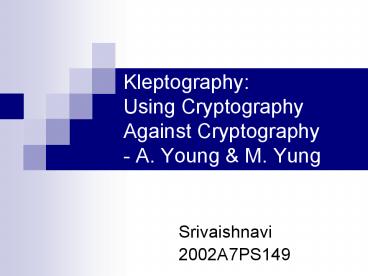Kleptography: Using Cryptography Against Cryptography - A. Young - PowerPoint PPT Presentation
1 / 20
Title:
Kleptography: Using Cryptography Against Cryptography - A. Young
Description:
Kleptography: Using Cryptography Against Cryptography - A. Young & M. Yung Srivaishnavi 2002A7PS149 – PowerPoint PPT presentation
Number of Views:65
Avg rating:3.0/5.0
Title: Kleptography: Using Cryptography Against Cryptography - A. Young
1
Kleptography Using Cryptography Against
Cryptography- A. Young M. Yung
- Srivaishnavi
- 2002A7PS149
2
Agenda
- Black Box Cryptosystems
- Subliminal channel
- Kleptography
- Kleptographic attack on Diffie-Hellman key
exchange protocol
3
Black Box Cryptosystems
- Implemented in such a way that the underlying
implementation cannot be scrutinized. - Has public I/O specification and its general
functionality is disclosed (though the true
functionality could differ). - E.g. Smart Cards, Cryptosystems implemented in
software
4
Subliminal Channel
- An information transmission channel that can be
used to send information out of (or potentially
into) a cryptosystem. - Characterized by the inability to be detected
when in use
5
Kleptography
- Kleptography is the study of stealing information
securely and subliminally. - It is dedicated to (re)searching ways of
obtaining data in an undetectable fashion with
high security guarantees. - It is a formal cryptographic study of backdoor
designs (beyond the naïve common attacks that are
detectable e.g. weak random generation). - Extension of subliminal channel
- Robust against reverse-engineering
- confidentiality of the stolen information holds
even after the black-box is opened and inspected.
6
Goal of kleptography
- To develop a robust backdoor within a
cryptosystem that - Provides the attacker with the desired secret
information (e.g., private key of the user) - Cannot be detected in black-box implementations
except by the attacker - If a reverse-engineer (i.e., not the attacker)
breaches the black-box, then the previously
stolen information remains confidential. Ideally,
confidentiality holds going forward as well.
7
Secretly Embedded Trapdoor with Universal
Protection (SETUP)
- If C is a black-box cryptosystem with a
publicly known specification, a SETUP mechanism
is an algorithmic modification made to C to get
C such that - C C are efficient algorithms
- Input of C agrees with the public specification
of the input of C - Output of C agrees with the public specification
of the output of C. At the same time, it contains
published bits (of the users secret key) which
are easily derivable by the attacker and not by
others. - Outputs C and C are polynomially
indistinguishable to everyone except the attacker
8
Leakage Bandwidth
- Leakage Bandwidth A (m,n) leakage scheme is a
SETUP mechanism that leaks m keys over n keys
that are output by the cryptographic device
(mltn).
9
Diffie Hellman protocol
- Alice chooses a randomly
- Alice sends A ga mod p to Bob
- Bob chooses b randomly
- Bob sends B gb mod p to Alice
- Alice computes k Ba mod p
- Bob computes k Ab mod p
- k Ba Ab mod p since gba gab mod p
10
Assumptions for the DH SETUP attack
- The black-box can store state information across
invocations of the Diffie-Hellman algorithm
(non-volatile memory). - The attacker can act as a passive eavesdropper on
all of Alice and Bobs key exchanges.
11
Parameters for the DH SETUP attack
- xm private key of attacker
- ym public key corresponding to xm. Hence, ym
gxm mod p. ym is placed inside the black-box that
Alice uses. - ID A random and secret bit string in Alices
device (Identifier). - H hash function generating values less than F(p)
12
(1,2) SETUP Attack
- First exchange
- Alices device sends A1 ga1 mod p to Bob
- Alices device stores a1 in non-volatile memory
- Bobs device sends B1 gb1 mod p to Alice
- Alice and Bobs devices compute k1 ga1b1 mod p
- Second exchange
- Alices device computes a2 H(ID (yma1 mod
p)) - Alices device sends A2 ga2 mod p to Bob
- Bobs device sends B2 gb2 mod p to Alice
- Alice and Bobs devices compute k2 ga2b2 mod p
13
Recovering the 2nd DH Shared Secret
- The attacker
- Obtains A1 and B2 via passive eavesdropping.
- Computes a2 H(ID (A1xm mod p))
- Computes k2 B2a2 mod p
- A1xm mod p ga1xm yma1 gxma1 mod p
- Note Only attacker can perform these
calculations since xm is known only to him
14
- a2 calculated as follows
- t e (0,1) chosen at random
- z ga1-Wt ym-c1a1-c2 mod p
- a2 H(z)
- A2 ga2 mod p
- W,c1 c2 fixed values
15
To show outputs of C C are polynomially
indistinguishable
- Let g1 g-xmc2-W, g2 g-xmc2, g3 g1-c1xm
- yma1c1c2gWtz ga1 mod p
- z g-xmc2-Wtg(1-c1xm) a1 gig3a1 mod p
- gi g3u mod p, for some integer u
- z g3 a1u mod p
- a1 uniformly chosen -gt z is uniformly distributed
- H is a pseudo-random function (whose domain is
Zp-1). - Therefore, a2 is distributed uniformly -gt values
output by C C are polynomially
indistinguishable
16
(l,l1) leakage bandwidth
- By chaining together the values that are leaked.
- a3 H(ID (yma2 mod p))
- ga3 mod p used in the next exchange
- When this is done l times, l contiguous DH keys
are leaked. - After l times, a1 is chosen entirely random
ensuring all contaminated keys behave differently.
17
Conclusions
- Vulnerability of black-box cryptosystems
- Security of kleptographic attack shows that DH
algorithm is provably insecure - Can be extended to RSA and other algorithms
18
References
- The Dark Side of Black Box Cryptography A.
Young M.Yung - Kleptography Using Cryptography against
Cryptography - A. Young M. Yung
19
Questions?
20
Thank You































